Ekonomika ISSN 1392-1258 eISSN 2424-6166
2020, vol. 99(2), pp. 116–131 DOI: https://doi.org/10.15388/Ekon.2020.2.8
Enterprise Research and Development Activity in Poland in Comparison to Eurozone Countries
Magdalena Gostkowska-Drzewicka
Faculty of Management
University of Gdansk, Poland
m.gostkowska@ug.edu.pl
ORCID ID: orcid.org/0000-0002-4383-7711
Ewa Majerowska
Faculty of Management
University of Gdansk, Poland
ewa.majerowska@ug.edu.pl
ORCID ID: orcid.org/0000-0003-0991-3714
Abstract. During the years 2000-2018, the number of enterprises conducting research and development activity in Poland was increasing systematically, thus the expenditures on research and development were increasing as well. The impact of R&D activity on the level of innovation of both enterprises and entire economies is related to objective and subjective structure of these expenditures which means that is not connected only with the value of the expenditures for its financing. The purpose of this paper is to present the level of expenditures on R&D in the business enterprise sector in Poland, in comparison to Eurozone countries and to analyze the convergence of value of these expenditures in Poland. The authors of the article used description and analysis of statistical data obtained from EUROSTAT and the GUS (General Statistical Office in Poland) statistics and estimation of econometric models and testing the occurrence of sigma and beta convergence. Based on the results, we state that the key issue is to further activate Polish enterprises within the sphere of research and development, because Poland, in comparison with Eurozone countries, ranks within the group of countries with low expenditures on research and development and with structures characteristic of less prosperous economies. The study allowed determination of occurrence of sigma and beta convergence in Poland, in comparison with the Eurozone countries.
Keywords: R&D, expenditures on research and development, the business enterprise sector, innovation, beta and sigma convergence
Received: 03/11/2020. Revised: 30/11/2020. Accepted: 07/12/2020
Copyright © 2020 Magdalena Gostkowska-Drzewicka, Ewa Majerowska. Published by Vilnius University Press
This is an Open Access article distributed under the terms of the Creative Commons Attribution License, which permits unrestricted use, distribution, and reproduction in any medium, provided the original author and source are credited.
Introduction
Enterprise development is of a qualitative nature and denotes changes consisting in the introduction of a product, and technological and organizational innovations. Such changes are perceived as a source of competitive advantage. Innovation is therefore of fundamental importance for the development process of individual enterprises and entire economies (Huang, Hou, 2019; Baum et al., 2019; Pradhan et al., 2018). An essential condition for emergence of innovation entails activity in the research and development (R&D) sphere. This activity and its impact on the level of innovation of both enterprises and entire economies are connected not only with the value of the expenditures for its financing, but also with the objective and subjective structure of these expenditures. Therefore, the purpose of this paper is to analyze the size and the structure of expenditures on research and development in the business enterprise sector in Poland, in comparison to Eurozone countries, as well as to analyze the convergence of value of these expenditures in Poland.
The research hypothesis assumes that Poland shows a tendency to a relatively faster growth rate than the average countries of the Eurozone. Moreover, the structure of R&D expenditures in Poland resembles the structure of other European economies, considered as developed. The reason for selecting these countries is that in 2018 Poland was promoted by FTSE Russell to a developed market status (www.stockwatch.pl).
Implementation of the research objective and verification of the research hypothesis required application of the following research methods:
• description and analysis of the statistical data obtained from the EUROSTAT and the GUS (General Statistical Office in Poland) statistics;
• estimation of econometric models and testing the occurrence of sigma and beta convergence.
The research period covers the years 2000-2018. The calculations were made in the Gretl package.
The article consists of an introduction, four elaborator parts and an ending. In the first part, the essence and the economic significance of research and development activity is explained. The second and the third parts contain analysis of the size and the structure of research and development expenditures in the business enterprise sector in Poland in comparison to Eurozone countries. The next part presents the methods of convergence testing and the research results, summarized in the conclusion. Monthly approach to the analysis of convergence was conducted by Bernardelli, Próchniak and Witkowski (2018). The authors tested the existence of beta convergence in EU-28 countries. The hypothesis of the convergence process was confirmed. However, the convergence between countries occurred at different rates.
1. The essence and economic significance of research and development activity
Research and development activity (R&D) is defined as creative work, undertaken in a methodical way, in order to increase knowledge resources, including the knowledge of mankind, culture and society, as well as to create new applications for existing knowledge. Research and development activity is always focused on new discoveries that are based on original concepts and their interpretations. As a rule, there is no certainty as to the final result or, at least, as to the amount of the time and the resources needed to achieve that result. The goal of R&D activity is to achieve effects that can be commercialized. Such activity must fulfill five conditions, namely, it needs to be (GUS, 2018):
• innovative,
• creative,
• unpredictable,
• methodological,
• transferable or reproducible.
Research and development activity consists of three categories:
• fundamental research,
• applied research,
• development work.
The term fundamental research (also called basic research or pure research) should be understood as theoretical and experimental work, carried out primarily in order to acquire or expand knowledge about various phenomena, on the causes of these phenomena and on specific facts. Fundamental research is not predominantly focused on getting practical solutions. This feature is characteristic of applied research, the essence of which entails the search for possible practical applications of the results of fundamental research. Such studies are therefore oriented at a concrete, practical goal and result in trial models of products, processes or methods. In contrast, development work consists in application of the existing knowledge, acquired in the course of research and development activities and during practical experience, and leads to formulation of new knowledge aimed at creation of new products or processes or at improvement of the existing products or processes (Baruk, 2006). This means that the essence of development research entails commercialization of the new solutions developed in the course of fundamental and applied research.
The special role of research and development activity is to formulate unique knowledge that would allow a given company to gain a competitive advantage, and therefore ensure its long-term development. This activity is also crucial with regard to the innovations implemented by a given company. Innovations result from human ingenuity, that is, the ability to discover and formulate the laws, principles and rules governing the world, to create new concepts, solutions and inventiveness, as well as to implement and disseminate those innovations. Innovations understood in this way rely on the use of new ideas to create value. This means that innovation is the driving force of the economy, a source of enterprise competitiveness and an opportunity to improve the living conditions of the society. The similar view is held by Shatilo (2019), who argued that an important factor of the company advancement is strategic management of innovation process. R&D can promote growth in total factor productivity (TFP) by helping to absorb new technologies embodied in foreign direct investment (FDI) and foreign trade (Shen et al., 2019). Various researchers, e.g. Grybaité and Stankevičiené (2018), Hamari et al. (2016) underline that technological progress or the latest technologies is the stimulus for the growth of sharing economy.
2. Literature review on convergence analysis
Many authors have dealt with the analysis of convergence. The research concerned the convergence of many economic phenomena. Monfort (2008) presents selected methods and developed statistical instruments that can be applied for testing and proving economic or social inequalities among countries. The author also showed that methods significantly differ from each other and due to that it is important to take into account all limits and disparities. The convergence analysis should be complex and the conclusions should be drawn on the results of the applications of many measures, not a single one.
The convergence of the East European countries, on the basis of the 10 years data was analyzed by Stavytskyy and Kozub (2020). The authors showed that the countries are not equally developed and there are no stable trends towards convergence of selected macroeconomic factors. In their analysis the beta and sigma convergences were employed. Grela et al. (2017) tested the convergence of six Central and Eastern European countries towards the EU-15 economies. Their research was based on the panel data 1997-2014 of 26 countries. One of the findings is that the global crisis in 2008 slower the convergence process. The authors showed a positive relationship between the scale of international trade and the growth rate of GDP per capita. The sigma convergence in EU-28 countries during 2000-2012 was tested by Simionescu (2014). An interesting result, obtained by the author, was a decrease in the divergence process in 2012 in comparison to 2000. The degree of variation was decreasing but the convergence process, in light of the analysis, was not confirmed. Głodowska (2015) tested the existence on sigma and beta convergence of EU countries and regions. The author proved the convergence process among EU countries and on the level of regions as well. The research showed that for countries this process is relatively faster and more clear than on the level of regions. Markowska-Przybyła (2011) tested changes in level of disparities in GDP of the EU countries and regions. The author analyzed GDP per capita during the period 1999-2008. Results showed that the differences between the GDP level in the countries were not evened out. The conclusion was that the convergence processes at the national level, within the EU countries, was accompanied by divergence processes at the regional level. The convergence beta, sigma and gamma of 28 EU countries and 16 non-EU post-socialist countries presented Próchniak (2019). The research included three subperiods: 1995-2004, 2004-2018 and 2010-2018. Results of the conducted analysis confirmed the three types of convergence in both groups of countries.
3. The size and the structure of expenditures on research and development activity in enterprises in Poland
The sum of intramural expenditures on the research and development work performed in a given country is the primary measure enabling assessment and comparison of the international magnitude of such activity. These expenditures are referred to using an abbreviation: GERD (Gross Expenditure on Research and Development). The publications addressing research and development activity most commonly assess the level of these expenditures in relation to the GDP of a given country (GERD/GDP), which illustrates the ratio of the total expenditures on research and development in four sectors (i.e. the business enterprise sector, the government and self-government sector, the higher education sector and the private non-profit institution sector) to the GDP (GUS, 2018). As underlined by Pomykalski (2001), the GERD index is the general measure of the intensity of research and development activity.
In turn, the concept of intramural expenditure refers to the R&D expenditures incurred in a given reporting year by a given reporting unit, regardless of the source of the funds. These expenditures include both the current expenditures and the capital expenditures associated with the R&D activity, without the fixed asset depreciation (GUS, 2018).
Economic innovativeness is shaped, among other factors, by the size and the structure of the expenditures on research and development work (Yazgan & Yalçinkaya, 2018). In Poland, during the years 2000-2011, the level of GERD in the enterprise sector was at a level of around 0.2% of GDP. It is worth noting, that in 2002 and between 2009-2011, the expenditures on research and development in the enterprise sector clearly had a smaller share in the GDP than the R&D expenditures incurred by the government sector. The reasons for this state of affairs should be sought in the changes in the economic situation. Research and development expenditures, like other investment activities, are of a cyclical nature. Expenditures on research and development activities are directly related to the economic cycle, therefore, they reflect the changes in the availability of financial resources and in the aggregate demand (Tylec, 2015). The decrease in enterprise expenditures on research and development, recorded during the aforementioned periods of economic downturn, was offset by an increase in government spending. Significant changes in the R&D expenditure trends, with regard to all examined sectors, occurred in 2012. During this period, a permanent increase in the GERD index, in the enterprise sector, was initiated, which was related to the gradual improvement of the economic situation at the time. During this period, some, though still weak, tendencies were also visible with regard to the increasing expenditures on research and development in the higher education sector. However, during the years 2016-2018, the GERD index in the government sector significantly decreased, which may be a positive sign of the changes taking place in the Polish economy (Figure 1). As Tylec (2015) emphasizes, a small a share of public funds in the financing of the total R&D activity is noticeable in countries with a high level of innovation. An opposite situation occurs in less innovative countries, where the high expenditures that are paid for by public funds may have resulted from low R&D expenditures in enterprises.
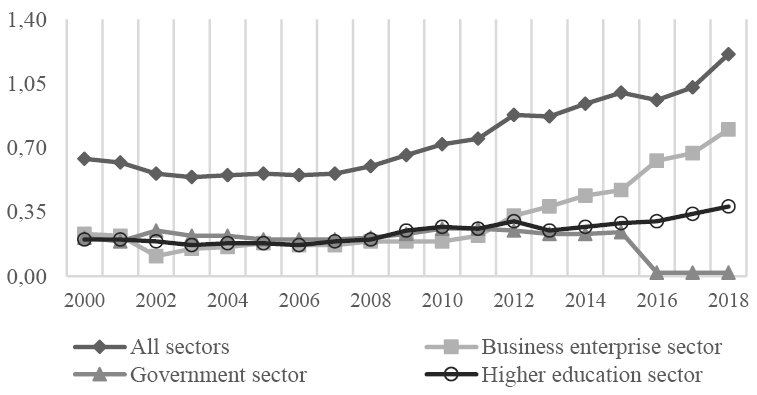
Figure 1. Relation of the volume of intramural R&D expenditures to the GDP (GERD), in Poland, by sector (%)
Source: Own elaboration, based on the Eurostat data (EUROSTAT, 2019-2020).
In the years 2000-2018, a nine and a half-fold increase in the number of enterprises conducting research and development activity occurred in Poland (Figure 2).
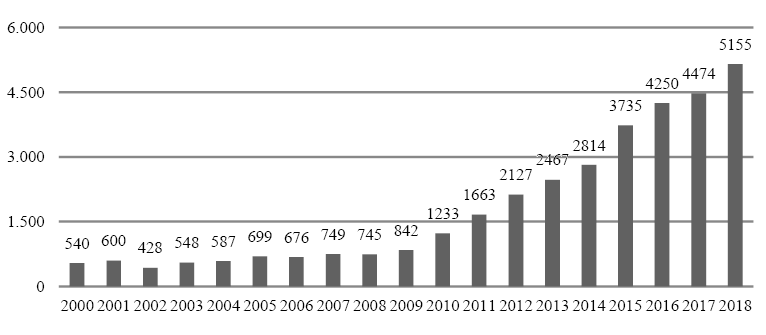
Figure 2. The number of enterprises conducting research and development activity in Poland, during the years 2000-2018
Source: Own elaboration, based on the Local Data Bank1 (GUS, 2020).
In the years 2000-2009, the number of enterprises involved in R&D activity was subject to slight fluctuations. Slight upward trends, however, could be observed during that period. In the second half of the 1990s, the small number of companies with their own R&D facilities partially resulted from the liquidation of enterprises at the time of economic transition and partly from the high cost of their maintenance (Janasz, Kozioł, 2007). Since 2010, the number of enterprises conducting research and development activity has been growing systematically. In 2018, 5155 such entities operated in Poland (Figure 2). The increase in the number of enterprises conducting R&D activity in Poland indicates the emergence of favorable trends. It should be assumed, that these entities are able to quite quickly carry out commercialization of the results of fundamental research, and thus can contribute to an increase in the innovativeness level of the Polish economy. The tendencies described are reflected in the increase in the total intramural expenditures in 2005-2018 in Poland, analyzed by the type of R&D activity carried out (Figure 3)2.
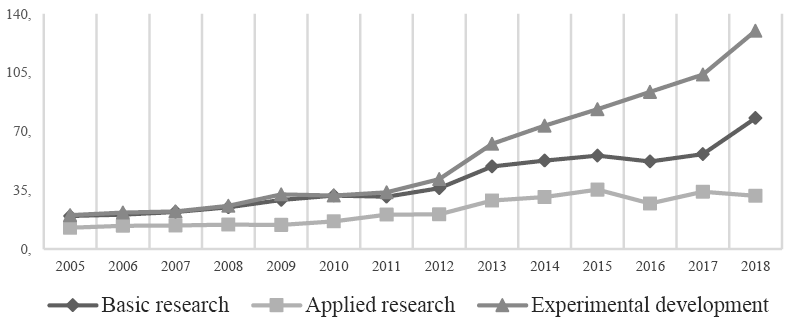
Figure 3. Total intramural expenditures, by type of research and development activity in Poland, during the years 2005-2018 (PPS per inhabitant at constant 2005 prices)
Source: Own elaboration, based on the Eurostat data (EUROSTAT, 2020).
During the years 2005-2012, the total intramural expenditures on basic and experimental development research were of similar value and showed similar trends of changes. In 2013, the value of expenditures on development research began to grow rapidly and in 2018 it amounted to around 130 PPS per inhabitant. In 2013-2015 there was a slight increase in the value of intramural expenditures on basic research. In turn, in 2016-2017 there was a slight decrease in this value. However, in 2018, the value of intramural expenditures on basic research increased rapidly. Within the category of the value of the funds for financing applied research, in 2005-2015, there were weak upward trends, which reversed in 2016 and fluctuated slightly in 2017-2018. It should be emphasized, that during the entire period under analysis, the value of expenditures on applied research was significantly lower than the value of expenditures on development and basic research (Figure 3). From the perspective of the effectiveness of research and development activity, the relatively low value of expenditures on applied research is not beneficial, because such research fosters implementation of innovation. In contrast, the change trends in the value of the funds allocated for development research should be assessed positively. The share of these expenditures in the total R&D expenditures is growing. As Tylec (2015) points out, highly developed countries spend a small part of the funds allocated for research and development work on fundamental research. Conversely, less prosperous countries, often those at a lower level of technological development and a lower level of innovation, allocate a much larger proportion of such funds for fundamental research.
Figure 4 illustrates the structure of the total expenditures on research and development activity in Poland, in the years 2000-2018, according to the source-of-funds criterion. The share of the R&D expenditures incurred by entities from the business enterprise sector was subject to certain fluctuations throughout the entire period under consideration. As already mentioned, these changes are cyclical. Expansion of enterprise research and development activity is observed during the periods of prosperity. This means that continuation of the upward trends, which were particularly visible in 2016-2018, to a large extent depends on further changes in the economic situation in Poland. It should be underlined, however, that the level of innovativeness in the enterprises whose determinants, among others, entail the expenditures on research and development activity, conditions the financial strength of the economy and its resilience to economic fluctuations (Spescha, 2019). For this reason, further activation of enterprises, in the sphere of research and development, is the key issue. However, innovation is very costly, and most small and medium enterprises are weak, therefore there is great need for reasonable and flexible institutional support systems (Lewandowska, Stopa, 2018). The instrument meant to stimulate such activity is the tax break for research and development activity, introduced into the Polish income tax system, as of 1 January 2016 (Zieliński, 2017). The essence of this tax break lies in the deductibility of eligible R&D expenses, incurred for this type of activity, from the taxable base. Also business support organizations, for example technological parks and incubators, influence the innovation activity of enterprises in Poland (Gorączkowska, 2018).
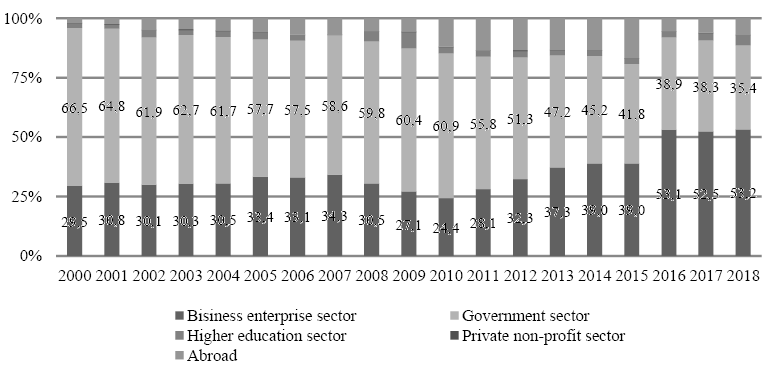
Figure 4. The structure of R&D expenditures in Poland, during the years 2000-2018, in relation to the source-of-funds criterion
Source: Own elaboration, based on the Eurostat data (EUROSTAT, 2020).
Figure 5 presents the value of intramural expenditures on research and development in the business enterprise sector in Poland during the years 2000-2018. A strong, systematic increase in these expenditures indicates an increase in the level of innovativeness in Polish enterprises. It also leads to creation of new products and technologies, improves the flow of information, promotes the level of production organization and efficiency and is an important driver of structural changes in the national economy. It can therefore be concluded that along with an increase in R&D expenditures, enterprises shift towards a knowledge-based economy.

Figure 5. Intramural R&D expenditures in the business enterprise sector in Poland, during the years 2000-2018 (Purchasing power standard (PPS) per inhabitant at constant 2005 prices)
Source: Own elaboration, based on the Eurostat data (EUROSTAT, 2020).
4. Enterprise research and development expenditures in Poland
and in Eurozone countries
Based on the data presented in Figure 6, it can be seen that the highest share of research and development expenditures in the GDP in 2018 was recorded in Finland, Germany and Austria. These countries spent from 2,76% to 3.14% of the GDP generated on R&D activities. The smallest share of research and development expenditures, amounting to only 0.6% of GDP, was noted in Malta. During the period under analysis, funds in the value of 1.21% of the GDP were allocated for this purpose in Poland.
In 2018, the highest total R&D expenditures out of selected European countries, was recorded in Germany and Austria. These countries allocated, for research and development, 1028,3 and 1050.2 PPS per capita respectively. It should be underlined, that out of the remaining countries, only Western and Northern European countries were included in the group of countries with high intramural expenditures on research and development. Within the group of countries under analysis, Poland was among the countries which spent less than 400 PPS per capita on R&D activity. It should be noted, that the countries which in the 1990s underwent economic and political transformation as well as the countries located in southern Europe were also classified among this group. Interestingly, this situation also applies to Italy, which ranks among the world’s richest countries (Figure 7).
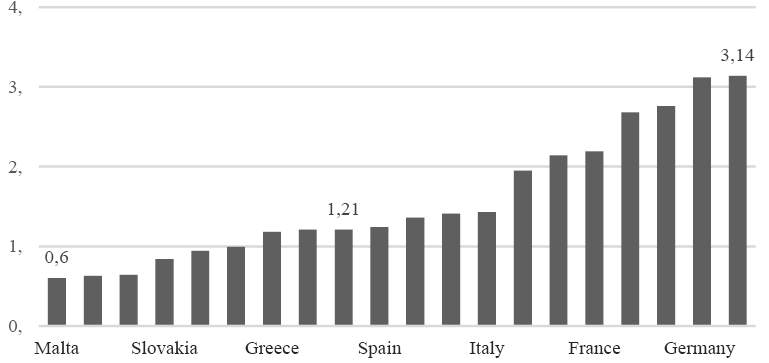
Figure 6. Relation of the amount of intramural R&D expenditures to the GDP (GERD), in Poland in comparison to Eurozone countries in 2018 (%)
Source: Own elaboration, based on the Eurostat data (EUROSTAT, 2020).
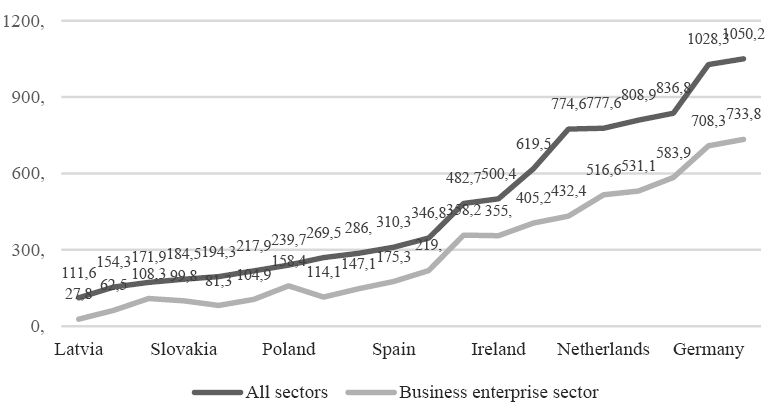
Figure 7. The value of intramural R&D expenditures in the business enterprise sector and total intramural R&D expenditures in Poland in comparison to Eurozone countries, in 2018 (Purchasing power standard (PPS) per inhabitant at constant 2005 prices)
Source: Own elaboration, based on the Eurostat data (EUROSTAT, 2020).
The highest value of intramural R&D expenditures in the business enterprise sector was recorded in Austria (738,8 PPS per capita). Out of all the countries under analysis, Poland, like most of the Southern European countries (except Italy) and the countries that underwent transformation in the 1990s, ranks as one of those with the lowest expenditures on research and development. In this context, attention should be drawn to Slovenia, where 358,2 PPS per capita was spent for this purpose in the business enterprise sector. This country, therefore, is positively distinguishable from among other economies that have undergone transformation (Figure 7).
In highly developed economies, most of the financial resources for R&D activity are incurred by enterprises. It should be emphasized, that the value of these expenditures is many times higher than the expenditures incurred by government institutions. Based on the data presented in Figure 8, this feature applies to Western and Northern European countries. In contrast, the countries which underwent economic and political transformation in the 1990s as well as those classified as Southern European countries, present similar patterns, with regard to the relation between the value of the research and development expenditures incurred by enterprises and those incurred by government institutions. In most cases however, including Poland, the value of these expenditures is very low. Slovenia, where in 2018 research and development expenditures in the enterprise sector reached the value of nearly 400 PPS per capita is an exception (Figure 8).
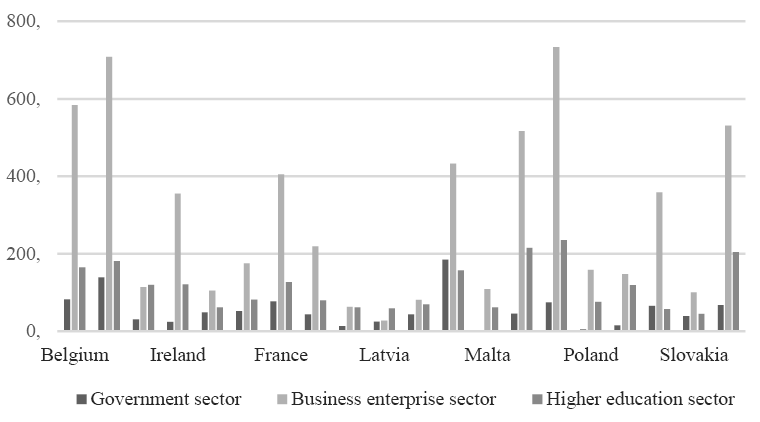
Figure 8. The value of intramural R&D expenditures in Poland in comparison to Eurozone countries in 2018, in a sectoral approach (Purchasing power standard (PPS) per inhabitant at constant 2005 prices)
Source: Own elaboration, based on the Eurostat data (EUROSTAT, 2020).
Figure 9 illustrates the structure of expenditures on research and development activities in Poland and Eurozone countries in 2018, according to the source-of-funds criterion. The country in which the research and development activity was financed by enterprise funds to the smallest extent were Cyprus, Lithuania and Estonia. An opposite situation was noted in Slovenia, where enterprises co-financed research and development expenditures by as much as 62.6%. In this respect, the situation noted in Poland should be assessed positively, since enterprises covered 53.2% of the total expenditures on research and development activities. A high share of enterprises acting as the founders of R&D activities is beneficial, because it means that these enterprises are interested in implementation and commercialization of innovations.
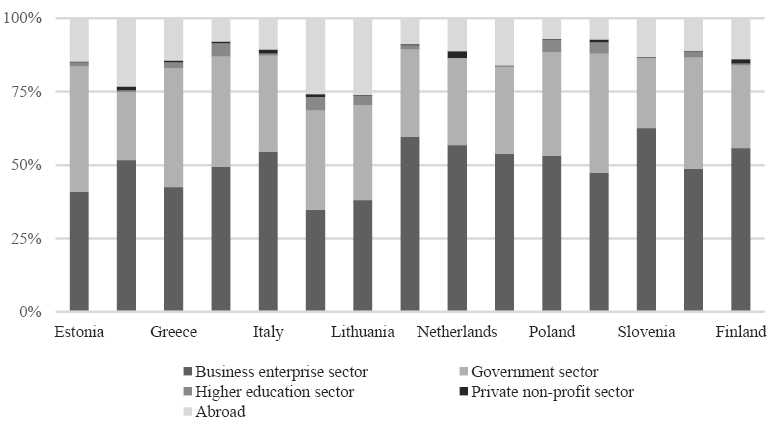
Figure 9. The structure of R&D expenditures in Poland in comparison to Eurozone countries in 2018, in relation to the source-of-funds criterion
Source: Own elaboration, based on the Eurostat data (EUROSTAT, 2020).
Figure 10 presents the values of total internal expenditures, in relation to the type of research and development activity in Poland and Eurozone countries in 2018. Due to the lack of data some countries were missing. Nevertheless, based on the available information, it can be concluded that highly developed countries allocate a smaller part of the funds spent on development and applied research for fundamental research. On the contrary, less wealthy countries allocate a much larger proportion of these funds for fundamental research.
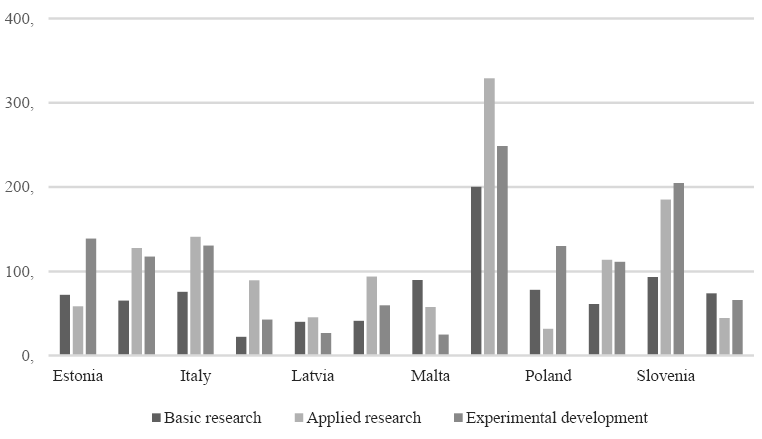
Figure 10. Intramural expenditures in Poland in comparison to Eurozone countries in 2018, in relation to the type of R&D activity (Purchasing power standard (PPS) per inhabitant at constant 2005 prices)
Source: Own elaboration, based on the Eurostat data (EUROSTAT, 2020).
5. Convergence of internal research and development expenditures in the enterprise sector
To assess whether the convergence process is taking place in Poland, taking into account internal research and development expenditures in the enterprise sector, in comparison with the average level of expenditures in the Eurozone countries (19 countries), widely recognized measures of convergence, such as the sigma and the beta convergence, were used (Kuc, 2017a, 2017b). With regard to this study, these measures will enable testing the hypothesis that Poland tends to grow faster than the Eurozone countries.
Convergence of the sigma-type means that, with the passage of time, the level of differentiation of a given variable per capita, among countries or selected regions, decreases. This variable represents the macroeconomic phenomenon analyzed. Initially, it was income, in subsequent works, the authors determined economic, social and other convergences.
Standard deviation of a logarithm of the variable’s value per-capita can be determined according to the formula (Kuc, 2013):
 (1)
(1)
where:
σ(t) – standard deviation of the product logarithm per capita, in a group of n countries;
n – the number of the countries analyzed;
zi(t) – the level of the product per capita, in the i-th country;
 – the average value from the product logarithm per capita, in a group of n countries.
– the average value from the product logarithm per capita, in a group of n countries.
Sigma convergence is assumed to occur when standard deviation values decrease over time, i.e. when:
σ(t) < σ (t – 1). (2)
Beta convergence is interpreted as a process of the country’s or the region’s adaptation (Czyż, Hauke, 2011). Existence beta convergence assumes that the growth rate in the countries with a higher starting position is relatively lower than in the less developed countries. To assess the occurrence of this type of convergence, a linear model is used, in the following form:
γi (t + T) = α + βlogzi (t) + ε, (3)
where:
α, β, γ – the model’s structural parameters;
zi(t) – the level of the products per capita in the i-th country;
γi (t + T) – the average return rate in the i-th country, in the period from t to t+T, calculated as:  .
.
Beta convergence occurs when the value of the structural parameter beta in model (3) is negative and statistically significant. The closer to the value of zero the parameter is, the lower the tendency for convergence to occur between the countries.
Using the annual data from the years 2000-2018, standard deviations of the logarithms of deviations from the pattern, that is the Eurozone average, were determined (Figure 11). Additionally, the trend line, estimated on the basis of 19 yearly observations, is marked on the graph. Its negative slope, which is confirmed by the results of the trend model estimation, can be see, which took the form of:


The negative and statistically significant, at the significance level of 0.05, value of the coefficient standing next to the time variable indicates sigma convergence.
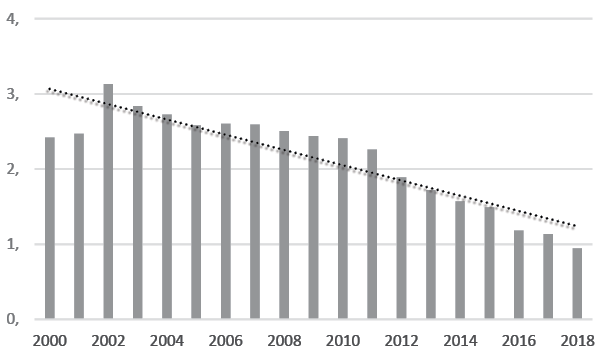
Figure 11. The values of the deviations from the pattern
Source: Own elaboration based on Eurostat data (EUROSTAT, 2020).
Looking at Figure 12, that presents the deviations of the natural logarithms of the internal research and development expenditures in the enterprise sector in Poland from the average level of this variable in Eurozone countries (19 countries), we can see a tendency to decrease differences between the analyzed time series.
Next, the values of the models’ structural parameters were determined in accordance with Formula 3. On the basis of 19 yearly observations the following form was obtained:


A negative and statistically significant structural parameter, equal to -0.30 confirms the existence of beta convergence. It is not a surprising result, as the average annual growth rate of research and development expenditures in the Eurozone countries during the years analyzed was 5.32%, while in Poland it was 12.06%.
Conclusion
During the years 2000-2018, the number of enterprises conducting R&D activity in Poland increased systematically. This contributed to the improvement of the competitiveness level of the Polish economy, because such entities are able to quickly commercialize the results of fundamental research. During the period under analysis, an increase in expenditures on research and development was noted as well. In particular, an increase in the spending on development research should be emphasized, because these expenditures are the most important, from the perspective of an increase in the level of innovation. Innovation determines the financial strength of an economy and its resilience to economic fluctuations. In this context, the key issue is to further activate enterprises in the sphere of research and development, because Poland, in comparison with other Eurozone countries, ranks as one of the countries with relatively low expenditures on research and development activity and with a structure characteristic of less prosperous economies. What is more, the study allowed determination of occurrence of sigma and beta convergence in Poland, in comparison with the Eurozone countries. This means that the hypotheses assumed in the introduction have been confirmed.
On the basis of the analyzes carried out, further convergence between R&D spending in Poland and other Euro area countries can be expected. However, it is not clearly obvious. The SARS-COVID-19 pandemic since the beginning of 2020 has led to an economic slowdown on an unprecedented scale. Undoubtedly, this will significantly disturb the course of the convergence that has taken place so far, because the development of enterprises from certain sectors characterized by a high level of innovation may even accelerate. Hover, this issue requires further research.
Reference
Bernardelli, M., Próchniak. M., Witkowski, B., (2018). Income Convergence in the EU Countries: Monthly Approach, Papers and Studies of Research Institute for Economic Development SGH, 100, 85-111
Baum, Ch. F., Lööf, H. Nabavi, P. (2019). Innovation strategies, external knowledge and productivity growth. Industry and Innovation, 26(3), 348-367, doi: 10.1080/13662716.2018.1499502
Baruk, J. (2006). Innovation and knowledge management. Toruń: Adam Marszałek Publishing House
Czyż, T., Hauke J. (2011). Evolution of regional disparities in Poland, Quaestiones Geographicae, 30(2), 35-48
EUROSTAT. (2019). Retrieved from http: //ec.europa.eu/eurostat/web/science-technology-innovation/data/database (02.01.2019)
Głodowska, A. (2015). Beta and Sigma Convergence within the European Union Countries and Regions. Conference: 6th Global Conference on Management in Recovering Markets, GCMRM 2015, At: University of Maribor, Maribor - Slovenia
Gorączkowska, J. (2018). Influence of business support organizations on innovation activity in manufacturing companies in the Masovian Voivodeship in Poland. Equilibrium. Quarterly Journal of Economics and Economic Policy, 13(4), 741–759. doi:10.24136/eq.2018.036
Grela, M., Majchrowska, A., Michałek, T., Mućk, J., Stążka-Gawrysiak, A., Tchorek, G., Wagner, M. (2017). Is Central and Eastern Europe converging towards the EU-15? NBP Working Paper No. 264
GUS. (2019). Local Data Bank. Retrieved from http: //stat.gov.pl/banki-i-bazy-danych/ (02.01.2019)
GUS. (2018). Frascati 2015 Manual, Recommendations for obtaining and presenting data in the field of research and development. Retrieved from http: //stat.gov.pl/banki-i-bazy-danych/ (02.01.2019)
Grybaité, V., Stankevičiené, J. (2018). An empirical analysis of factors affecting sharing economy growth. Oeconomia Copernicana, 9(4), 635–654. doi: 10.24136/oc.2018.031
Hamari, J., Sjöklint, M., Ukkonen, A. (2016). The sharing economy: why people participate in collaborative consumption. Journal of the Association for Information Science and Technology, 67(9), 2047-2059, doi: 10.1002/asi.23552
Huang, C.H., Hou T.C.T. (2019). Innovation, research and development, and firm profitability in Taiwan: Causality and determinants. International Review of Economics and Finance, 59, 385-394, doi: 10.1016/j.iref.2018.10.004
Janasz, W., Kozioł, K. (2007). Determinants of innovative activity of enterprises. Warsaw: PWE
Kuc, M. (2013). Social convergence in Europe, PTE Toruń and IER Working Papers 4/2013
Kuc, M. (2017a). Social convergence in Nordic countries at regional level. Equilibrium. Quarterly Journal of Economics and Economic Policy, 12(1), 25-41
Kuc, M. (2017b). Is the regional divergence a price for the international convergence? The case of the Visegrad group. Journal of Competitiveness, 9(4), 50-65
Lewandowska, A. Stopa, M. (2018). SMEs innovativeness and institutional support system: the local experiences in qualitative perspective. Polish case study. Oeconomia Copernicana, 9(2), 333-351, doi: /10.24136/oc.2018.017
Markowska-Przybyła, U. (2011). Integration versus real convergence. Regional convergence in Poland according to classical and alternative methods of research. Economics, 4(16), 77-96
Monfort, P. (2008). Convergence of EU regions. Measures and evolution. European Union Regional Policy Working Papers, 01/2008
Pomykalski, A. (2001). Innovation management. Warsaw: PWN
Pradhan, R., Arvin, M.B., Bahmani, S. (2018). Are innovation and financial development causative factors in economic growth? Evidence from a panel granger causality test, Technological Forecasting and Social Change, 132(C), 130-142, doi: 10.1016/j.techfore.2018.01.024
Próchniak M. (2019). Beta, Sigma, and Gamma Convergence of Post-socialist Countries to Western Europe. Yearbook of the Institute of East-Central Europe. 17 (1), 217-243, DOI: 10.36874/RIESW.2019.1.10
Shatilo, O. (2019), The Impact of External and Internal Factors on Strategic Management of Innovation Processes at Company Level, Ekonomika, 98(2), 85-96; DOI: https://doi.org/10.15388/Ekon.2019.2.6
Shen, X., Boqiang, L., Wei, W. (2019). R&D Efforts, Total Factor Productivity, and the Energy Intensity in China. Emerging Markets Finance and Trade, 55(11), 2566-2588, doi: 10.1080/1540496X.2019.1579709
Simionescu, M. (2014). Testing sigma convergence across EU-28, Economics&Sociology, 7(1), 48-60, doi: 10.14254/2071-789X.2014/7-1/5
Spescha, A. (2019). Innovation and firm growth over the business cycle. Industry and Innovation, 26(3), 321-347, doi: 10.1080/13662716.2018.1431523
Stavytskyy, A. V., Kozub, M. B. (2020). Modeling of Economic Convergence Processes in Eastern Europe Countries, Ekonomika, 99(2), 6-19, doi: https://doi.org/10.15388/Ekon.2020.2.1
Tylec, T. (2015). The amount and the structure of research and development financing in economically developed countries. Conclusions for Poland, Studia Ekonomiczne, 210, 242-253
Yazgan, Ş., Yalçinkaya, Ő. (2018). The Effects of Research and Development (R&D) Investments on Sustainable Economic Growth: Evidence from OECD Countries (1996-2015). Review of Economic Perspectives, 18(1), 3-23, doi: 10.1515/revecp-2018-0001
Zieliński, R. (2017). Research and Development Allowance as a Development Instrument of Entrepreneurs in Poland, Annales H – Oeconomia, 51(6), 525-533, doi: http://dx.doi.org/10.17951/h.2017.51.6.525